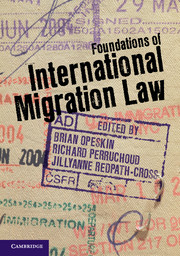Book contents
- Frontmatter
- Summary contents
- Detailed contents
- Preface
- List of case studies
- List of boxes
- List of figures
- List of maps
- List of tables
- Notes on contributors
- Abbreviations
- 1 Conceptualising international migration law
- 2 Contemporary patterns of international migration
- 3 Sources of international migration law
- 4 Nationality and statelessness
- 5 State sovereignty and freedom of movement
- 6 International human rights of migrants
- 7 Refugees and asylum
- 8 Women, children and other marginalised migrant groups
- 9 Human trafficking and smuggling
- 10 International migration by sea and air
- 11 International labour migration
- 12 International trade law and labour mobility
- 13 Global migration institutions and processes
- 14 Regional processes, law and institutional developments on migration
- 15 Emerging legal issues in international migration
- Appendix 1 Cases
- Appendix 2 Treaties and other international instruments
- Glossary
- Index
- References
7 - Refugees and asylum
Published online by Cambridge University Press: 05 November 2012
- Frontmatter
- Summary contents
- Detailed contents
- Preface
- List of case studies
- List of boxes
- List of figures
- List of maps
- List of tables
- Notes on contributors
- Abbreviations
- 1 Conceptualising international migration law
- 2 Contemporary patterns of international migration
- 3 Sources of international migration law
- 4 Nationality and statelessness
- 5 State sovereignty and freedom of movement
- 6 International human rights of migrants
- 7 Refugees and asylum
- 8 Women, children and other marginalised migrant groups
- 9 Human trafficking and smuggling
- 10 International migration by sea and air
- 11 International labour migration
- 12 International trade law and labour mobility
- 13 Global migration institutions and processes
- 14 Regional processes, law and institutional developments on migration
- 15 Emerging legal issues in international migration
- Appendix 1 Cases
- Appendix 2 Treaties and other international instruments
- Glossary
- Index
- References
Summary
During the late nineteenth and early twentieth centuries, European governments enacted a series of immigration laws under which international migration was constrained in order to maximise advantage for States. These new, largely self-interested laws clashed with the enormity of a series of major population displacements within Europe, including the flight of more than a million Russians between 1917 and 1922, and the exodus during the early 1920s of hundreds of thousands of Armenians from Turkey. The social crisis brought on by the de facto immigration of so many refugees – present without authorisation in countries where they enjoyed no protection and no ability to support themselves legally – convinced European governments that the viability of the overall migration control project depended on building into that regime a needs-based exception for refugees. Providing specifically for refugees would legitimate what was, in any event, an unstoppable phenomenon; it would thus reinforce the viability of the protectionist norm. Equally important, enfranchising those who were unlawfully present would defuse social tensions in States of reception and position refugees to make a positive contribution to their new societies.
THE EVOLUTION OF INTERNATIONAL REFUGEE LAW
Between 1920 and 1950, the League of Nations and other intergovernmental bodies were given the task of administering refugee protection, commencing with the mandate of Fridtjof Nansen in the 1920s. This was an extraordinarily fluid era, with the refugee definition evolving from an initial focus on groups of de jure stateless persons; then refocussing on groups of persons who were de facto disfranchised (i.e., deprived of the substantive benefits of nationality) under the National Socialist regime in Germany; and, in the post-war era, embracing individuals in search of escape from perceived injustice in their home State. Not only did the definition of a refugee shift from a juridical, to a social, and finally to an individualist perspective, but the actual rights guaranteed to refugees under the succession of refugee treaties also changed over time. Drawing on the normative structures of international law of aliens and the interwar minorities treaties, the duties owed to refugees were sometimes defined in mandatory terms, sometimes as benchmarks to be strived for. The critical duty of non-refoulement – not to return refugees to a territory where they may face persecution – first appeared in 1933.
- Type
- Chapter
- Information
- Foundations of International Migration Law , pp. 177 - 204Publisher: Cambridge University PressPrint publication year: 2012
References
- 10
- Cited by



